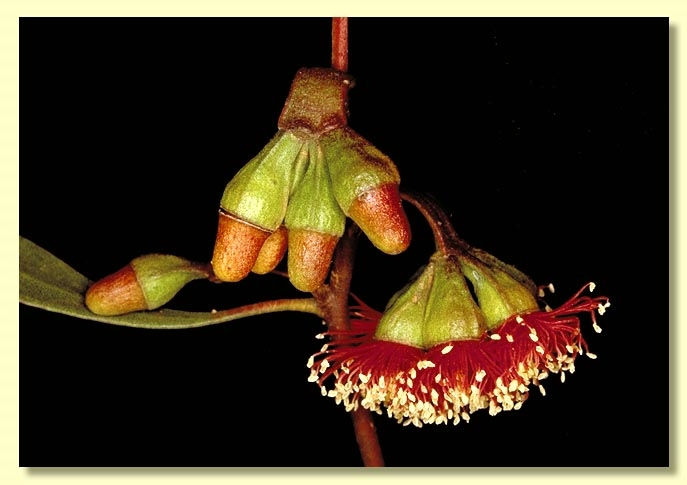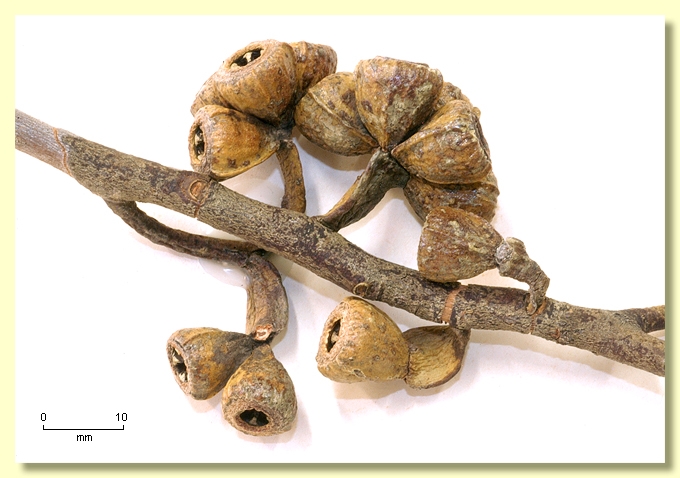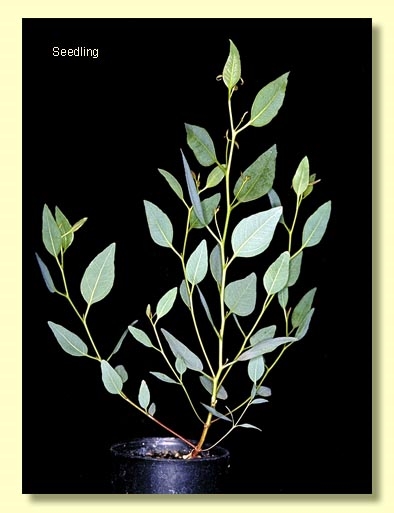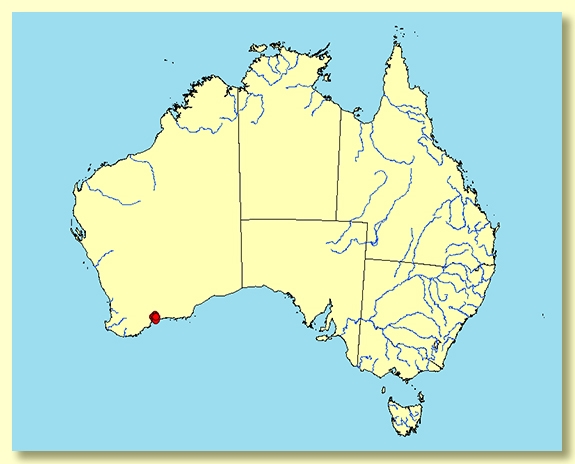Euclid - Online edition
Eucalyptus proxima
Eucalyptus | Symphyomyrtus | Bisectae | Glandulosae | Clinatae
Mallee to 3 m tall though often smaller. Lignotuber present.
Bark smooth throughout, grey over pale orange or coppery.
Branchlets with oil glands in the pith.
Juvenile growth (coppice or field seedlings to 50 cm): stems rounded in cross-section; juvenile leaves always petiolate, opposite at lowest node only then alternate, ovate to lanceolate, 4–7.5 cm long, 1.5–3 cm wide, base tapering, apex pointed, green.
Adult leaves alternate, petioles 1–2(2.6) cm long; blade usually lanceolate, 4.7–8.5 cm long, 1.5–2.3(3) cm wide, base tapering to petiole, margin entire or shallowly subcrenulate in upper half, apex pointed, concolorous, glossy, green, "glazed", side-veins acute or obscure, reticulation obscure, intramarginal vein remote from margin, oil glands numerous, island, irregular in shape.
Inflorescence axillary unbranched, peduncle broadly flattened, usually down-turned, 1.2–2.2 cm long, buds 7 per umbel, sessile to very shortly and stoutly pedicellate (pedicels 0.1–0.4 cm long). Mature buds more or less ovoid (0.8–1.5 cm long, 0.5–0.9 cm wide), egg-in-eggcup shape, i.e. the operculum narrower than the hypanthium at the join, scar present (outer operculum shed very early), operculum rounded-hemispherical or slightly elongated and rounded at top, smooth, hypanthium with 2 prominent longitudinal ridges/angles (and often 1 less prominent rib/angle also, rarely a fourth rib/angle present), stamens all inflexed (outer stamens only partly inflexed, inner more so), anthers narrowly oblong, versatile, dorsifixed, dehiscing by longitudinal slits, style long and straight, stigma blunt, locules 5-6(very rarely 4), the placentae each with 4 vertical rows of ovules. Flowers commonly red to pink, less commonly yellowish.
Fruit peduncles usually down turned, fruit sessile or shortly pedicellate (pedicel 0–0.4 cm long), stoutly obconical to slightly campanulate, 0.9–1.3 cm long, 0.8–1.4 cm wide, with 2 prominent (and often 1 less prominent) longitudinal ridges, rim flat with disc descending from it, valves 5-6(very rarely 4), rim level.
Seeds brown, 1–1.5 mm long, flattened-ovoid, dorsal surface clearly but shallowly reticulate, hilum ventral.
Cultivated seedlings (measured at node 10): cotyledons Y-shaped (bisected); stems rounded in cross-section; leaves always petiolate, opposite for 3 to 5 nodes then alternate, ovate, 4–8 cm long, 1.5–3.5 cm wide, dull, green. Lignotuber obvious.
Flowering has been recorded in September, October and November.
Eucalyptus proxima is a small mallee occurring only in the Ravensthorpe to Hopetoun area of southern Western Australia, where found on the southern Ravensthorpe Range, Eyre Range and the country between and also near Hamersley Inlet, in mallee scrub on rocky slopes and low raised areas of sandy gravelly soil. It has smooth bark, glossy green leaves with side-veins visible but reticulation obscured by numerous oil glands. The egg-in eggcup buds have a reddish operculum and green base and occur in clusters of 7 on strap-like, usually down-turned, peduncles. It may flower when small, less than a metre tall.
E. proxima is most likely to be confused with its close relative E. cernua which is a mallet (lacks a lignotuber) of taller stature. E. cernua is restricted to the Ravensthorpe Range and east to Bandalup Hill, usually on lower sites on more clayey soils than E. proxima. Both species have colourful flowers that may be shades of yellow, pink and red. To accurately separate the two species note will need to be made of habit and habitat as bark, leaves, buds and fruit are similar. The closely related mallet E. vesciculosa has buds with a prominently warty operculum, broader leaves and occurs further west near Corackerup. The more widespread mallee E. suggrandis subsp. suggrandis overlaps in distribution with E. proxima but can always be distinguished by having fully erect stamens in bud and often a warty operculum.
Eucalyptus proxima was published after the classification of the eucalypts published by Brooker (2000). Within that classification it would be placed in Eucalyptus subgenus Symphyomyrtus section Bisectae subsection Glandulosae because the buds have an operculum scar, cotyledons are bisected and branchlets have oil glands in the pith. Within this very large group (some 80 species) E. proxima is, however, only closely related to three other species, the mallets E. cernua and E. vesiculosa and probably also to the mallee E. vegrandis. Together these 4 species form series Clinatae characterised by having angled buds with a short operculum narrower than the hypanthium, inflexed stamens on a broad staminophore, leaves with many oil glands but not obscuring the main side-veins, and down-turned bud clusters.
When Brooker & Hopper (2002) published the description of E. cernua they included both lignotuberous (mallee) and non-lignotuberous (mallet) forms under this name. Nicolle & Brooker (2005) separated the mallee and mallet entities within E. cernua as two distinct species. Because the type specimen of the name E. cernua was known to be taken from a non-lignotuberous plant a new name, Eucalyptus proxima, was erected to cater for the populations of plants that have lignotubers.
For many years the name Eucalyptus nutans F. Muell. was misapplied (collectively) to red-flowered plants of E. cernua and E. proxima, and was used in horticulture. However the type specimen of E. nutans represents a coastal species of mallet habit from Bremer Bay and east of Albany well to the south-west of the now known distribution of E. cernua and E. proxima. Typical E. nutans has a similar mallet habit and adult leaf form to E. platypus and, like that species, has erect stamens within the bud.
Eucalyptus proxima: from Latin proximus meaning nearest, referring to its close raletionship, both taxonomically and geographically, with E. cernua.









